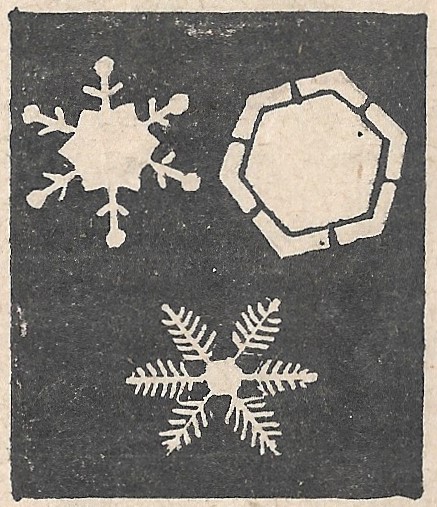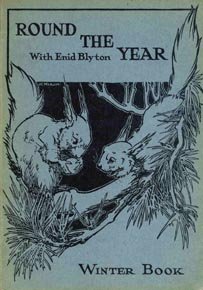Winter is firmly here in Scotland. It has been in minus figures most days for the past few weeks, not ideal when our only options for activities outside the house are the garden, walks and playparks. Going for a walk when it’s crisp and cold can be lovely, but it’s nicest when it’s a choice and not done simply because you’ll lose the plot if you stare at the same four walls (or your toddler’s epic mess) any longer.
Anyway, I like to post seasonal content, so here are a few things that Blyton wrote about winter. Maybe we can find a new appreciation for the season! I make no pretence that this is an exhaustive list, though, it’s just around a dozen things I noted down, there will be much more out there.
Nature-lovers’ Corners
We all know that Enid Blyton was big on nature, and despite winter seeming quite a barren month to those of us in the UK, she still found plenty to write about. I have to admit although I have a mild interest in animals and birds, I know very little about flowers and trees.
In volume 1 issue 19 of Enid Blyton’s Magazine Blyton says that this is the time of year to learn to know the evergreen trees and bushes. She adds that it’s quite clear which ones these are, as they’re the only one still with leaves (even I knew that!).
She also mentions the robins who, in winter put on their scarlet waistcoats… [and] now they look like proper little redbreasts!
Blyton begins by starting her Nature-lovers’ corner for December 9 1953 (volume 1 issue 20 of Enid Blyton’s Magazine) with a question.
What sort of a month will this turn out to be? Mild and fair with a few primroses opening their pale petals in sheltered corners? Or bitterly cold, with frost and snow, and all the ponds frozen?
Well, for me December 2020 was somewhere in-between, while January is firmly in frozen pond territory! (I read a lovely new story the other day about a 77 year old who went skating on an Edinburgh pond on her 50 year old skates!)
Blyton continues by reminding us that December 21st and 2nd are the shortest days of the year – though the days seem to be getting longer very slowly, and advising us to watch the stars at night and to try to catch some snowflakes to examine their shapes.
In volume 3 issue 23 of Enid Blyton’s magazine has Blyton giving us something for us to find
She suggests putting out a bird table (as this is from November it is to ‘tame’ the birds, it may be too late to do such a thing in January), and you may see at least nine different kinds of birds – blackbirds, thrush, starling, robin, sparrow, chaffinch, and two or three kinds of tit.
Blyton also suggests looking for spruce trees which have a straight spike at the top, and six-inch pine cones.
More things for us can be found in volume 3 issue 25 of Enid Blyton’s Magazine.
She advises looking at bird prints in the snow to see which birds hopped across it and which ran. Hopping birds’ prints will be side by side while running ones are one behind the other. Coincidentally I spotted some clear bird prints on my walk in between sessions of writing this blog! Some running and hopping ones, I think.
There are long Nature Notes for January in Enid Blyton’s Book of the Year.
It begins with As the day lengthens, the cold strengthens. I’m glad to see that it’s not just me imagining that January and February are colder than December!
She also says, though, that a cold January usually means a good spring, so here’s hoping! The notes are then divided into sections; birds, which are the usual suspects, trees, flowers (not many unless it’s very mild), animals (many still sleeping), insects (few apart from moths).
Poems
Trees in Winter (from Enid Blyton’s Magazine, volume 5 issue 25)
Elm and chestnut and beach and lime
Are bare and brown in the winter-time
Oak and sycamore, birch and plane,
Have hardly a leaf to catch the rain!
Ash and maple and poplar tall
Haven’t a leaf to show at all!
But holly and fir and cedar and pine
Stand up straight in a well-dressed line,
And juniper, privet, laurel and yew
Wear their leaves all the winter through!
Maybe they feel the cold and so
They never undress when the chill winds blow!
This rather reminds me of the poem used to remember which months have thirty or thirty one days – only useful if you can actually remember which order the names go in!
Cold Weather (from Enid Blyton’s Magazine, volume 1 issue 20)
The sky is grey, the wind is cold,
The hungry birds are tame and bold,
There’s ice beside the running river
Where the wagtails stand and shiver.
Frost climbs up each blade of grass,
And every puddle shines like glass;
The lane is powdered white with snow
And carefully the horses go
For fear they will slip; within the fold
The little lambs are safe from cold,
And when we breathe, our breath comes out
Like steam from any kettle-spout
The Robin (from the Water-Lily Story Book)
Here I am with chest puffed out
To keep away the cold,
Upon your sill I hope about,
A robin bright and bold
My eye is black, my chest is red,
I bob and flick and bend,
Oh haven’t you a mite of bread
To throw your little friend?
Jack Frost (From Enid Blyton’s Book of the Year)
Every little twig of brown
He lightly powders up and down,
Every blade of grass is bright
With tiny crystals, dazzling white;
On the spider threads he grows
Frosty beads in shining rows,
Changing into fairy lace
All the webs in every place!
He sits upon our window-sill
And paints with rare and loving skill
Leaf and frond in rich design
On your window-pane and mine.
Silently he comes and goes,
Unseen as the wind that blows.
Leaving loveliness behind
For our eyes to seek and find.
Snow (from Enid Blyton’s Book of the Year)
Nothing is so quiet as the snow;
It falls from out a leaden sky
Upon the wintry ground to lie
Without a murmur, silently and slow.
Like a fleecy blanket, softly spread
Upon each sleeping field and hill,
It shelters them in warmth until
They stir and rouse within their wintry bed
Then silent as it came, the dazzling snow
As silent goes, within a night;
And here and there the snowdrops white
Put up their heads, and sweetly nod and blow.
I actually like it when it snows; at first at least. It looks lovely and playing in it can be fun, but it becomes tiresome when it inevitably freezes and it becomes treacherous to walk anywhere.
Short stories
Jack Frost features heavily in the stories I found.
Who could it be? (Enid Blyton’s Magazine, volume 3 issue 25)
One winter afternoon Sam and Valerie walk home on frosty grass that sounds like toast as it crunches under their feet. Valerie comments how lovely everything looks, and how she’d like to paint it, and then they spot a small man, rather thin who is doing just that, but when he sees them he runs off with his easel.
Sam picks up a sketch book the man has dropped and it is full of detailed drawings of ferns, over and over, so rather dull. But then the last pages are full of what the children realise are snow crystals. The book is signed by a JF, and they can’t work out who that could be.
That night is very cold and when they wake up the next morning their windows are covered in the same snow crystal pattern as the last pages of the book. Then they realise who JF is – Jack Frost!
Jack Frost is About (From the Foxglove Story Book)
When Jean’s mother tells her that it’s Jack Frost that brings the cold weather Jean goes outside and shouts out that she doesn’t really believe in him, but he shouts back! She responds how she doesn’t like how he kills plants and makes everything cold.
They then have a conversation where he defends himself and says he will prove to her that he is real – and he does so by drawing on her windows that night.
Jack Frost is About (Brownie’s Magic p 49)
This series of books is slightly odd as although they look like a standard Blytonian collection of short stories each is a nature lesson hidden in a story. They are almost fiction and non-fiction at the same time.
This story teaches children how deciduous trees are not dead in the winter, as they all have little buds containing leaves which will begin to grow again in the spring. This is achieved by having Jack Frost boasting about how he’s killed the trees and an owl correcting him, and showing him how it is the trees are alive.
Jack Frost the Painter (from the Daffodil Story Book)
This one I don’t have a copy of, I have the Daffodil Story Book but it’s a later reprint which is unfortunately heavily abridged.
Whole Book
Blyton also wrote a whole book about winter – the Round the Year with Enid Blyton series has a book for each season.
The winter book is split into 10 chapters:
- How things make ready for the winter
- The story of frost and snow
- The creeping snail
- Making friends with the birds
- The compass
- Our evergreens
- The robin and the wren
- Foot-writing in the snow
- Twigs and their story
- The friendly tits
Most of these chapter headings are fairly self-explanatory. The snail chapter also covers slugs though I’m not sure how related to winter it is, other than to say that snails close over their shells during cold snaps. The compass is similarly unrelated to winter, but I expect Blyton had a list of topics she wanted to cover and the compass is no less related to winter than any other season!
Twigs and their story covers the same information as in Jack Frost is About, but in more detail.
Each chapter also has a few ideas of things to do related to the subject of the chapter.
There’s too much in the book to really go into any detail here but maybe I’ll review it soon (or next year if I run out of time this winter!)
There is also Winter Stories, one of the newer Hodder short story collections. You can see the contents here, and although many of the titles don’t sound wintry I assume they are at least set in the winter.
Further reading
A few years ago Stef pulled together a couple of lists of Christmas and winter-themed books, if you are in the mood for your books to match the weather outside. Part one is here and part two, here.
















Lovely illustrations. I recognized Eileen A. Soper.
BTW neither last week nor this week can I read your answer at the upper right corner (bell with an orange dot). It doesn’t open for me. 😦
LikeLike
Christmas is a time for going to the panto — except that this year there sadly aren’t any, as the Theatres are all closed. I expect you’d have a traditional one at the Glasgow Empire, Fiona, if it still produced them!
So I would recommend instead ‘The Mystery of the Pantomime Cat’, even though it really isn’t very Christmassy, except for mentioning a pantomime.
LikeLike